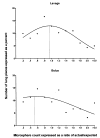Lavage administration of dilute surfactant in a piglet model of meconium aspiration
- PMID: 15636195
- PMCID: PMC1315299
- DOI: 10.1007/s00408-004-2505-4
Lavage administration of dilute surfactant in a piglet model of meconium aspiration
Abstract
Maldistribution of exogenous surfactant may preclude any clinical response in acute lung injury associated with surfactant dysfunction. Our previous studies have shown the effectiveness of surfactant lavage after homogenous lung injury. The present study utilizes a histologically confirmed non-homogeneous lung injury model induced by saline lung-lavage followed by meconium injected into a mainstem bronchus. Piglets were then treated with Infasurf or Exosurf by lavage (I-LAVAGE, n = 7; E-LAVAGE, n = 5) or bolus (I-BOLUS, n = 8; E-BOLUS, n = 5), or went untreated (CONTROL, n = 4). Lavage administration utilized a dilute surfactant (35 ml/kg; 4 mg phospholipid/ml) instilled into the lung, followed by gravity drainage. The retained doses of the respective surfactant in the lavage and bolus groups were similar. Results showed that the surfactant distribution was more uniform in the lavage groups compared to the bolus groups. Significant and consistent increases in PaO2 were observed in the lavage groups compared to the bolus groups and the controls. PaO2 (mmHg) at 240 min posttreatment: I-LAVAGE = 297 +/- 54, E-LAVAGE = 280 +/- 57; I-BOLUS = 139 +/- 31; E-BOLUS = 152 +/- 29; C = 119 +/- 73 (mean +/- SEM). Other improved pulmonary function parameters favored lavage administration. We conclude that better surfactant distribution achieved by lavage administration can be more effective than bolus administration in this type of non-homogeneous lung injury.
Figures




References
-
- Auten RL, Notter RH, Kendig JW, Davis JM, Shapiro DL. Surfactant treatment of full-term newborns with respiratory failure. Pediatrics. 1991;87:101–107. - PubMed
-
- Balaraman V, Hashiro G, Sood SL, et al. Physiologic response and lung distribution of lavage versus bolus exosurf in piglets with acute lung injury. Am J Respir Crit Care Med. 1996;153:1838– 1843. - PubMed
-
- Balaraman V, Meister J, Ku TL, et al. Lavage administration of dilute surfactants after acute lung injury in neonatal piglets. Am J Resp Crit Care Med. 1998;158:12–17. - PubMed
-
- Chen CT, Toung TJK, Rogers MC. Effect of intra-alveolar meconium on pulmonary surface tension properties. Crit Care Med. 1985;13:233–236. - PubMed
-
- Cleary GM, Wiswell TE. Meconium-stained amniotic fluid and the meconium aspiration syndrome: an update. Pediatr Clin North Am. 1998;45:511–529. - PubMed
Publication types
MeSH terms
Substances
Grants and funding
LinkOut - more resources
Full Text Sources

